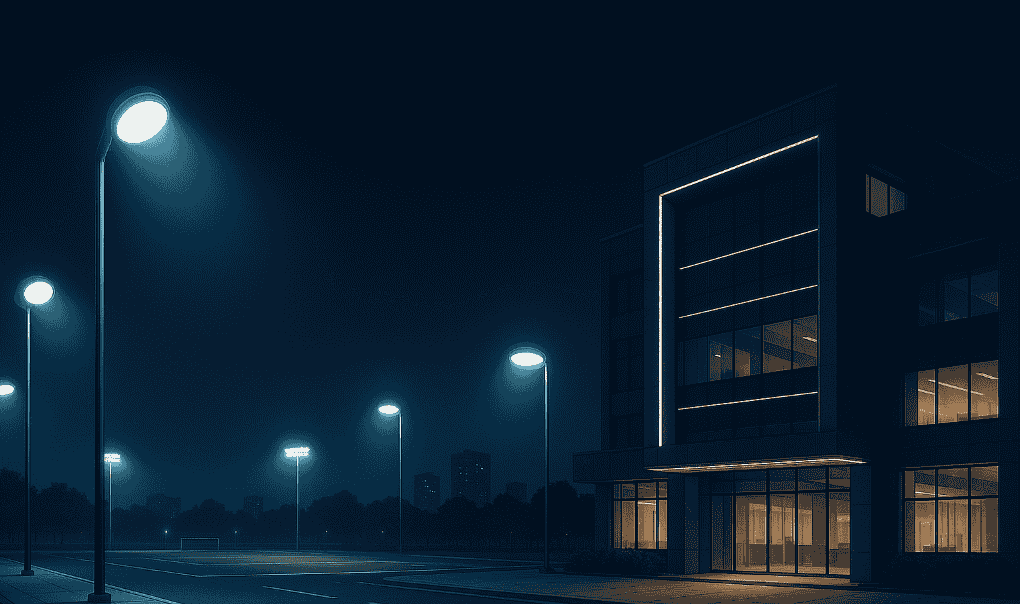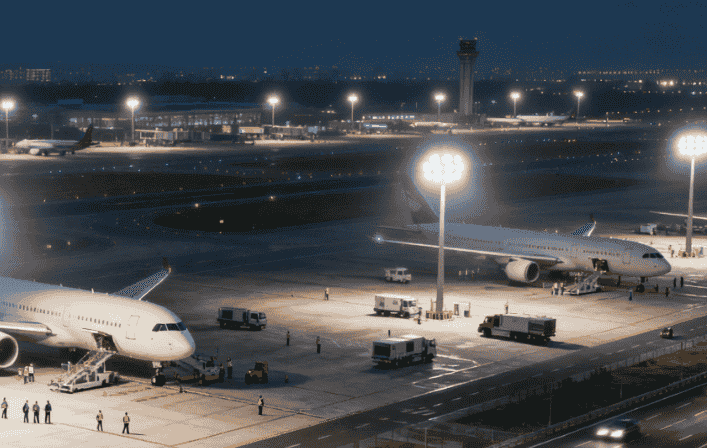The Science and Strategic Applications of Outdoor LED Flood Lights

Directory:
1. Introduction: Why Outdoor LED Flood Lights Matter
2. The Science Behind Outdoor LED Flood Lights
3. Key Applications of Outdoor LED Flood Lights
4. Comparing Outdoor LED Flood Lights with Legacy Systems
5. Future Trends in Outdoor LED Flood Lighting
6. Conclusion: Strategic Value of Outdoor LED Flood Lights
1. Introduction: Why Outdoor LED Flood Lights Matter
Outdoor LED flood lights have evolved into a critical component for modern infrastructure, combining energy efficiency, precision illumination, and long-term cost savings. For businesses, municipalities, and industrial operators, the choice of flood lighting is no longer limited to brightness alone—it is about how advanced optics, spectrum control, and smart integration can improve safety, extend operational hours, and reduce total cost of ownership.
This article examines both the science behind outdoor LED flood lights and the diverse applications that make them indispensable across commercial, municipal, and industrial environments.
2. The Science Behind Outdoor LED Flood Lights
Before evaluating applications and investment decisions, it is critical to understand the core technology that drives outdoor LED flood lights. At their heart lies advanced semiconductor engineering: electrons move across a diode junction, releasing photons in a highly controlled spectrum.
This process produces directional light with remarkable efficiency, minimizing wasted energy and maximizing usable illumination compared to traditional luminaires such as metal halide or sodium vapor lamps.
Optical Precision – Unlike legacy HID or halogen lamps, LED flood lights utilize sophisticated lenses and reflectors to direct light exactly where it is needed. This precision reduces light spill, improves uniformity, and ensures that every lumen contributes to functional or aesthetic objectives. For security zones, sports arenas, or architectural facades, such precision is critical for both performance and compliance.
Spectral Flexibility – LED chips can be tuned to deliver a wide range of color temperatures, from warm to neutral to daylight, and can even be customized for specialized applications such as sports broadcast, architectural accenting, or enhanced security surveillance. This tunability enables lighting solutions that are tailored to human perception, camera systems, or specific operational requirements.
Thermal Management – Efficient heat sinks and advanced thermal pathways allow outdoor LED flood lights to dissipate heat effectively, even in extreme climates. This thermal engineering not only extends operational life—often exceeding 50,000 hours—but also maintains stable light output over time, ensuring consistent performance in demanding environments.
Electrical Efficiency – Outdoor LED flood lights achieve luminous efficacy exceeding 120–150 lumens per watt, dramatically lowering electricity costs relative to legacy options. This efficiency contributes directly to reduced total cost of ownership, faster ROI, and improved sustainability metrics, making LEDs an attractive choice for energy-conscious organizations.
.png)
By combining optical precision, spectral flexibility, robust thermal management, and exceptional electrical efficiency, outdoor LED flood lights do more than simply replace older fixtures—they transform the possibilities of outdoor illumination.
From strategic security deployment to high-performance sports arenas and visually impactful architectural lighting, these systems offer operational, financial, and environmental advantages that legacy lighting technologies cannot match.
3. Key Applications of Outdoor LED Flood Lights
Outdoor LED flood lights are far more than a generic lighting solution; their true value lies in versatility, efficiency, and performance across diverse industries. From enhancing safety and productivity to elevating aesthetics and sustainability, these advanced lighting systems are transforming the way businesses, municipalities, and industrial operators illuminate their facilities.
Below, we explore the key applications of outdoor LED flood lights that demonstrate their impact on operations, safety, and energy management.
(1) Industrial and Commercial Security
Maintaining well-lit perimeters, loading docks, and parking areas is a cornerstone of modern security strategies. Outdoor LED flood lights provide broad, uniform coverage with high color rendering, enabling security cameras to capture sharper footage and improving overall visibility. Their instant-on capability ensures there is no delay during power fluctuations—a limitation common to traditional HID or metal halide systems.
For warehouses, logistics hubs, or retail centers, upgrading to outdoor LED flood lights reduces liability risks, deters unauthorized access, and lowers long-term energy costs through improved efficiency.
(2) Sports and Recreational Facilities
From municipal football pitches to world-class Olympic venues, outdoor LED flood lights have revolutionized sports illumination. Adjustable beam angles, high CRI (Color Rendering Index), and precise light distribution enhance player performance and spectator experience. Integrated dimming and smart control systems also ensure compliance with broadcast requirements for televised events.
A regional stadium replaced legacy 1,000-watt metal halide lamps with outdoor LED flood lights, achieving a 40% reduction in energy consumption while halving maintenance downtime, demonstrating clear operational and cost benefits.
(3) Architectural and Landscape Illumination
In applications where aesthetics matter as much as visibility—such as hotels, commercial real estate, and civic landmarks—outdoor LED flood lights deliver both functional and decorative illumination. Their spectral tuning and directional optics create dramatic contrasts that accentuate architectural features while keeping energy use low.
Use narrow-beam outdoor LED flood lights for façade accenting and wide-beam models for open plazas or landscape illumination, ensuring visual appeal without excessive energy consumption.
(4) Transportation and Infrastructure Projects
Ports, airports, highways, and rail yards operate around the clock, requiring robust and reliable lighting solutions. Outdoor LED flood lights withstand harsh weather, vibration, and environmental stress while maintaining consistent illumination. Their durability, energy efficiency, and compliance with environmental standards make them increasingly specified in infrastructure tenders.

Many public and private tenders now mandate LED lighting for its measurable reduction in CO₂ emissions and long-term sustainability advantages.
(5) Industrial Production and Worksites
Construction sites, mining operations, and large-scale manufacturing yards benefit from both fixed and portable outdoor LED flood lights. High-quality illumination improves worker safety, enhances productivity, and supports compliance with occupational health standards.
Outdoor LED flood lights can be integrated with motion sensors or IoT-enabled control systems, providing adaptive illumination only when required, reducing energy waste and operational costs.
4. Comparing Outdoor LED Flood Lights with Legacy Systems
Outdoor lighting is a critical investment for industries ranging from infrastructure and logistics to sports and urban planning. Choosing the right technology affects not only visibility and safety but also long-term operational costs and environmental performance.
| Feature | Metal Halide / Sodium Vapor | Outdoor LED Flood Lights |
|---|---|---|
| Energy Efficiency | 60–90 lm/W | 120–150+ lm/W |
| Warm-up Time | 5–10 minutes | Instant-on |
| Lifespan | 10,000–15,000 hours | 50,000+ hours |
| Color Rendering (CRI) | Poor to moderate | High (80+) |
| Maintenance Frequency | Frequent | Minimal |
| Environmental Compliance | Mercury content | RoHS compliant, no toxic materials |
This comparison underscores why the global market is rapidly transitioning toward outdoor LED flood lights as the standard solution. LEDs outperform traditional systems in nearly every category—delivering higher efficiency, lower maintenance, and greater sustainability without compromising on light quality.
5. Future Trends in Outdoor LED Flood Lighting
The evolution of LED flood lighting is entering a new phase where advanced functionality meets sustainability goals. Over the next decade, we will see:
Smart Controls: Integration with IoT platforms for real-time monitoring, adaptive dimming, and predictive maintenance.
Renewable Integration: Solar-powered LED flood lights gaining traction, reducing reliance on grid electricity and aligning with ESG targets.
Human-Centric Design: Solutions optimized for glare reduction, uniform light distribution, and reduced ecological impact on nocturnal wildlife.
Data-Driven Operations: Sensors embedded within lighting systems providing insights on energy usage, security, and occupancy patterns.
Forward-looking businesses that adopt these innovations early will gain measurable advantages—ranging from operational efficiency and reduced total cost of ownership (TCO) to stronger sustainability reporting for stakeholders.
6. Conclusion: Strategic Value of Outdoor LED Flood Lights
Outdoor LED flood lights represent far more than a technical replacement for legacy systems—they are a strategic asset for modern infrastructure. Their advances in optical design, spectrum control, and thermal management translate into practical benefits for sectors as diverse as transportation, logistics hubs, sports facilities, architectural projects, and public security.
For decision-makers, the investment case is compelling. LEDs deliver:
Superior performance with higher lumen output and better visibility.
Extended lifecycle that minimizes downtime and service costs.
Sustainability advantages through energy savings, mercury-free compliance, and compatibility with renewable energy.
In an era where operational efficiency and ESG performance are board-level priorities, outdoor LED flood lights provide businesses with a competitive edge that legacy technologies simply cannot match.
_thumb.jpg)